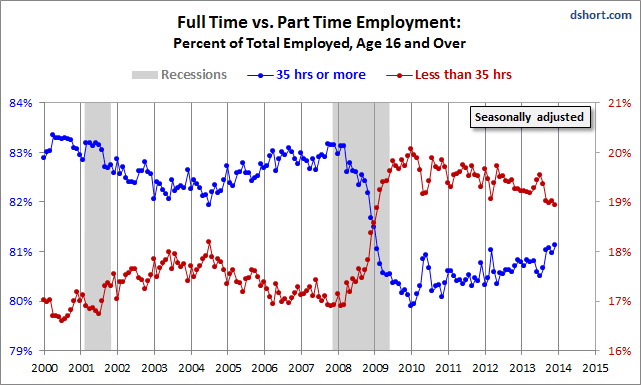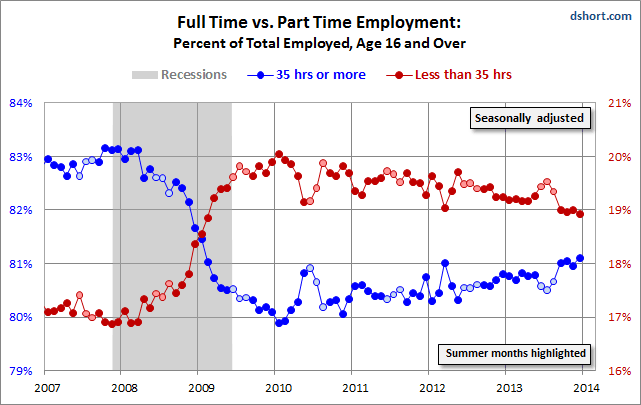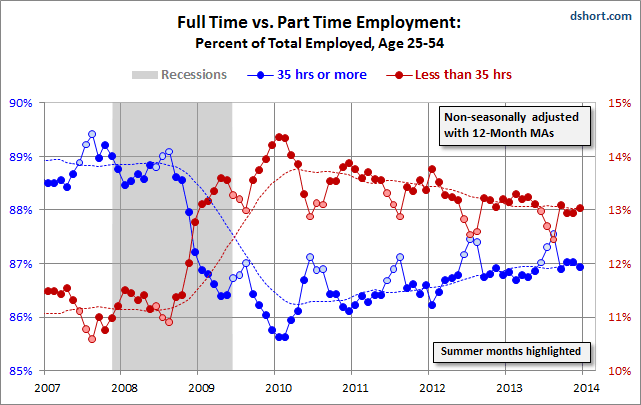Let's take a close look at today's employment report numbers on Full and Part-Time Employment. Buried near the bottom of Table A-9 of the government's Employment Situation Summary are the numbers for Full- and Part-Time Workers, with 35-or-more hours as the arbitrary divide between the two categories.
The Labor Department has been collecting this since 1968, a time when only 13.5% of US employees were part-timers. That number peaked at 20.1% in January 2010. The latest data point, going almost four years later, is only modestly lower at 18.9%.
Here is a visualization of the trend in the 21st century, with the percentage of full-time employed on the left axis and the part-time employed on the right. We see a conspicuous crossover during Great Recession.
The Impact of the Great Recession
Here is a closer look since 2007. The reversal began in 2008, but it accelerated in the Fall of that year following the September 15th bankruptcy of Lehmann Brothers. In this seasonally adjusted data the reversal peaked in early 2010. Over three-and-a-half years later the spread has narrowed a bit, but we're a long way from returning to the ratio before the Great Recession.
The two charts above are seasonally adjusted and include the entire workforce, which the CPS defines as age 16 and over. A problem inherent in using this broadest of cohorts is that it includes the population that adds substantial summertime volatility to the full-time/part-time ratio, namely, high school and college students. Also the 55-plus cohort includes a subset of employees that opt for part-time employment during the decade following the historical peak spending years (ages 45-54) and as a transition toward retirement.
The Core Workforce: Ages 25-54
The next chart reduces the summertime volatility problem by focusing on the 25-54 workforce. Note that the government's full-time/part-time data for this cohort is only available as non-seasonally adjusted. To help us recognize the summer seasonality that remains, I've used a lighter color for the summer-month markers, which are the most subject to temporary shifts from part-time to 35-plus hours of employment. I've also included 12-month moving averages for the two series to help us identify the slope of the trend over the past three years.
Like the 16-and-over version, this chart depicts a current situation that is considerably different from the era before the Financial Crisis, although the trend has been slowly improving since early 2010, as illustrated by the dotted-line moving averages. Since this is non-seasonally adjusted data, the summer months are obvious outliers, with full-time employment spiking during the June-August period. In July 2012 and again in August 2013 the data points nudged each other. For the last two months, not surprisingly, the spread returned. We can certainly hope the dotted lines will continue to slope toward each other and eventually cross back to the old normal for this core population segment. But at the current rate, it will take years for the numbers to return to the pre-recession percentages.
Over the past year many have speculated that the Affordable Care Act (aka Obamacare) has played a role in company decisions about full-time versus part-time employment. The $2,000 per employee penalty for companies that do not comply with regulations has influenced some to rethink their employment policies. In July the government pushed the start of the penalty from January 2014 to January 2015. But the anticipation of the penalty, even though delayed a year, may influence the decisions of private employers.
With regard to Obamacare and part-time employment, one thing is crystal clear: The surge in part-time employment was triggered by the recession, not by the Affordable Care Act, as the next chart clearly illustrates.
The Bureau of Labor Statistics' monthly employment report is a hodgepodge of data. The full-time/part-time ratio is but a tiny piece of the whole, and the magic 35-hour threshold is arguably arbitrary. But this is, nevertheless, a metric that bears close watching as we try to understand where the economy is headed. The big question is whether the ratio shift is the result of a structural change initially triggered by the Great Recession but now driven by a combination of several factors, not least of which are workplace demographics and ongoing increases in technology-driven productivity with less dependence on human workforce participation.
- English (UK)
- English (India)
- English (Canada)
- English (Australia)
- English (South Africa)
- English (Philippines)
- English (Nigeria)
- Deutsch
- Español (España)
- Español (México)
- Français
- Italiano
- Nederlands
- Português (Portugal)
- Polski
- Português (Brasil)
- Русский
- Türkçe
- العربية
- Ελληνικά
- Svenska
- Suomi
- עברית
- 日本語
- 한국어
- 简体中文
- 繁體中文
- Bahasa Indonesia
- Bahasa Melayu
- ไทย
- Tiếng Việt
- हिंदी
The Full-Time/Part-Time Employment Ratio Shows Little Improvement
Published 01/10/2014, 02:39 PM
Updated 07/09/2023, 06:31 AM
The Full-Time/Part-Time Employment Ratio Shows Little Improvement
3rd party Ad. Not an offer or recommendation by Investing.com. See disclosure here or
remove ads
.
Latest comments
Install Our App
Risk Disclosure: Trading in financial instruments and/or cryptocurrencies involves high risks including the risk of losing some, or all, of your investment amount, and may not be suitable for all investors. Prices of cryptocurrencies are extremely volatile and may be affected by external factors such as financial, regulatory or political events. Trading on margin increases the financial risks.
Before deciding to trade in financial instrument or cryptocurrencies you should be fully informed of the risks and costs associated with trading the financial markets, carefully consider your investment objectives, level of experience, and risk appetite, and seek professional advice where needed.
Fusion Media would like to remind you that the data contained in this website is not necessarily real-time nor accurate. The data and prices on the website are not necessarily provided by any market or exchange, but may be provided by market makers, and so prices may not be accurate and may differ from the actual price at any given market, meaning prices are indicative and not appropriate for trading purposes. Fusion Media and any provider of the data contained in this website will not accept liability for any loss or damage as a result of your trading, or your reliance on the information contained within this website.
It is prohibited to use, store, reproduce, display, modify, transmit or distribute the data contained in this website without the explicit prior written permission of Fusion Media and/or the data provider. All intellectual property rights are reserved by the providers and/or the exchange providing the data contained in this website.
Fusion Media may be compensated by the advertisers that appear on the website, based on your interaction with the advertisements or advertisers.
Before deciding to trade in financial instrument or cryptocurrencies you should be fully informed of the risks and costs associated with trading the financial markets, carefully consider your investment objectives, level of experience, and risk appetite, and seek professional advice where needed.
Fusion Media would like to remind you that the data contained in this website is not necessarily real-time nor accurate. The data and prices on the website are not necessarily provided by any market or exchange, but may be provided by market makers, and so prices may not be accurate and may differ from the actual price at any given market, meaning prices are indicative and not appropriate for trading purposes. Fusion Media and any provider of the data contained in this website will not accept liability for any loss or damage as a result of your trading, or your reliance on the information contained within this website.
It is prohibited to use, store, reproduce, display, modify, transmit or distribute the data contained in this website without the explicit prior written permission of Fusion Media and/or the data provider. All intellectual property rights are reserved by the providers and/or the exchange providing the data contained in this website.
Fusion Media may be compensated by the advertisers that appear on the website, based on your interaction with the advertisements or advertisers.
© 2007-2024 - Fusion Media Limited. All Rights Reserved.
